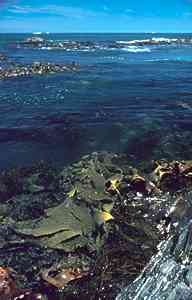|
|
Nutrient Absorbers
 Algae
absorb sunlight by photosynthesis and convert solar energy into chemical
energy which they use in growth or to store within the cell. Algae are
the primary producers within this marine ecosystem.
Algae
absorb sunlight by photosynthesis and convert solar energy into chemical
energy which they use in growth or to store within the cell. Algae are
the primary producers within this marine ecosystem.
Algae are grouped into three major groups. These are the Phylum Chlorophyta or Green Algae, the Phylum Phaeophyta the Brown Algae and Phylum Rhodophyta, the Red Algae.
Unlike land plants which obtain their nutrients from the soil by absorption through roots, algae absorb the nutrients they require directly from the seawater that surrounds and supports their fronds. Algae do not have absorption roots, their holdfast only holds them down onto a firm surface.
The large algae that we see on a shore are called macroalgae, and unusually there are surprisingly few shore animals that live entirely by eating algae fronds.
The other algae group is the microalgae, consisting of single-celled plants, spores, and minute juvenile plants which occur in their millions suspended in the water as plankton or coating the rocks as part of the deposited slime, or gaining a foothold to grow into a larger plant.
Large algae plants produce thousands of cells in each frond and on the frond surface. Under the constant swashing of the waves, these cells erode away from the plant. These cells become suspended in the water and are subjected to bacterial action. Others are filtered and consumed by other animals.
Some examples of green algae are:
![]() Sea
lettuce, Ulva lactuca
Sea
lettuce, Ulva lactuca
![]() Green
Sea Velvet, Codium fragile
Green
Sea Velvet, Codium fragile
![]() Caulerpa,
Caulerpa filiformis
Caulerpa,
Caulerpa filiformis
Some examples of brown algae are:
![]() Neptune's
Necklace, Hormosira banksii
Neptune's
Necklace, Hormosira banksii
![]() Leather
Kelp, Eklonia radiata
Leather
Kelp, Eklonia radiata
![]() Strap
Weed, Phyllospora comosa
Strap
Weed, Phyllospora comosa
Some examples of red algae are:
![]() Coralline
Seaweed, Corallina officinalis
Coralline
Seaweed, Corallina officinalis
![]() Encrusting
Corallines, Corallinaceae species.
Encrusting
Corallines, Corallinaceae species.
References:
Clayton, M.N. & King, R.J. (1981). Marine Botany: an Australian perspective. Longman Cheshire.
Cremona, J. (1988). A Field Atlas of the Seashore. p. 32, Cambridge University Press, Cambridge.
Pope, E.C. & McDonald, P.M. (1981). Exploring Between Tidemarks. p.27, The Australian Museum.
Nutrient
Absorbers
Grazers & Browsers
Suspension Feeders
Deposit Feeders
Carnivores
Omnivores
Trophic Levels
Energy Pyramid
Home
Page
Taxonomy
Biogeography
Rocky Shores
Tidal Levels
Intertidal Zonation
Environmental Factors
Biological
Factors
Feeding Relationships
Activities
Glossary
References
 Life
on Australian Seashores
Life
on Australian Seashores
by Keith Davey (C) 2000
Learning Consultant
- Media
The University of Newcastle
email at australian_seashores@hotmail.com
Scientific Consultant: Phil
Colman
site created 01.01.98 : updated 01.04.2000
